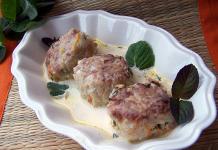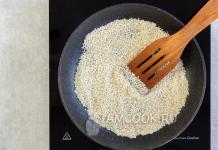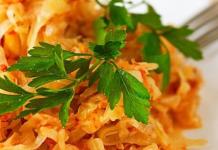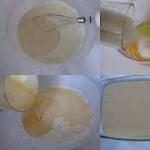Cabbage is a product that nature itself created for dietary nutrition. Its calorie content is low - only 28 calories per 100 grams, but the benefits are enormous. White cabbage contains a set of vitamins B1, B2, B6, C, PP, provitamin A and vitamin U. It contains large quantities of microelements: potassium, calcium, phosphorus, manganese, iron. In addition, this healthy vegetable contains biological active substances, enzymes, pantothenic and folic acids, various organic substances that are so necessary for us to function normally.
It is for this reason that cabbage and dishes made from it are widely used not only in normal nutrition, but also in the treatment of a number of diseases. It is believed that regular consumption of white cabbage dishes has a beneficial effect on the functioning of the entire body.
Cabbage has a pronounced antiulcer effect;
She has excellent diuretic, choleretic and laxative effects;
Cabbage leaves have anti-inflammatory, analgesic and hemostatic properties;
Cabbage heals wounds well and helps with stomatitis;
It strengthens the blood vessels of the heart and brain, helps fight atherosclerosis;
Stimulates the immune system, has a general strengthening and tonic effect;
Stimulates digestion, cleanses the intestines, helps in the fight against obesity.
Helps with burns and skin diseases.
Cabbage is widely used in dietetics. Cabbage dishes are included in the menu of many diets (cabbage diet for 7 days, cabbage diet for 10 days, sauerkraut diet, cabbage-carrot diet, cabbage diet for 1 month, etc./
But even if you are absolutely healthy and are not struggling with excess weight, be sure to include cabbage in your diet. This could be sauerkraut, which has only 23 calories per 100 grams, stewed cabbage, cabbage juice, or fresh cabbage salad. In any case, the benefits from it will be undoubted. But be careful, if you have chronic intestinal diseases, you need to use cabbage carefully.
This is interesting! One head of cabbage weighs 1.5-3 kg. But there are also giant specimens weighing 5-6 kg. The largest head of cabbage weighing 34 kg 400 grams was grown by American John Evans.
Table of calorie content and nutritional value of white cabbage.
| Product name | Number of grams of product | Contains |
| fresh white cabbage | 100 grams | 28 kcal |
| stewed cabbage | 100 grams | 54-60 kcal |
| sauerkraut | 100 grams | 23 kcal |
| proteins | 100 grams | 1.8 gr. |
| fat | 100 grams | 0.1 gr. |
| carbohydrates | 100 grams | 4.7 gr. |
| dietary fiber | 100 grams | 2 gr. |
| water | 100 grams | 90.4 gr. |
100 grams of white cabbage contain the following micro and macroelements:
Iron 0.6 mg;
Zinc 0.4 mg; Iodine 3 mcg; Copper 75 mcg; Manganese 0.17 mg; Selenium 0.3 mcg; Chromium 5 mcg; Fluoride 10 mcg; Molybdenum 10 mcg; Boron 200 mcg; Cobalt 3 mcg; Aluminum 570 mcg; Nickel 15 mcg; Calcium 48 mg; Magnesium 16 mg; Sodium 13 mg; Potassium 300 mg; Phosphorus 31 mg; Chlorine 37 mg; Sulfur 37 mg
100 grams of cabbage contain the following vitamins: Vitamin PP 0.7 mg; Beta-carotene 0.02 mg; Vitamin A (VE) 3 mcg; Vitamin B1 (thiamine) 0.03 mg; Vitamin B2 (riboflavin) 0.04 mg; Vitamin B5 (pantothenic) 0.2 mg; Vitamin B6 (pyridoxine) 0.1 mg; Vitamin B9 (folic) 10 mcg; Vitamin C 45 mg; Vitamin E (TE) 0.1 mg; Vitamin H (biotin) 0.1 mcg; Vitamin K (phylloquinone) 76 mcg; Vitamin PP (Niacin equivalent) 0.9 mg; Choline 10.7 mg
Nika Sestrinskaya -specifically for the site site
You can seriously discuss the calorie content of stewed cabbage only if you stewed it yourself. Or watched the process, recording and weighing. On the Internet, on a site focused on tasty, but not healthy food, you can find two dozen recipes for this cabbage of varying calorie content. Someone first fries vegetables with onions on vegetable oil, without measuring it, but simply pouring it into the pan. Someone does the same thing, but with butter. Others do not use oil, but fill the cabbage with a mixture of tomato paste and flour with sour cream. In general, as many people as there are, so many opinions. The calorie content of the standard “canteen” version of this dish is 122 kcal per 100 g, mainly from fats and carbohydrates. “Lite” options may vary. It also makes no sense to memorize any single table value. Nowhere is it disclosed exactly how much of the notorious oil and flour was added to the “tabular” cabbage. However, some versions of this dish are considered terribly healthy.
Contents of the article:
If you take the “Healthy Lifestyle Recipe”, in which shredded cabbage and 1 onion are first simmered in water, and then a spoonful of sugar-free tomato paste is added, and everything is stewed until tender - this is a very healthy dish. First of all, the volume of vegetables is large, and the caloric output is no more than 40 kcal per 100 g. This is so low because no oil is added during cooking. This is the main complaint about this recipe. For many people, this cabbage resembles the notorious Bonn soup. It seems that the soup is healthy, and it’s hot... but you don’t get enough of it, and that’s all.

However, these are the vegetables that are recommended to be eaten by those who want to lose weight through a diet. Most often, such a dish appears in a simple “fist, fist and palm” layout. That is, a fist-sized portion of vegetables (in this case, cabbage), an equal-sized portion of grains, and a palm-sized portion of protein sources. Cabbage is one of the cheapest vegetables and its consumption contributes not only to health, but also to significant savings.
The fiber in cabbage can:
- increase the volume of the food bolus and save a person from the eternal pangs of hunger that haunt everyone who suddenly decides to lose weight through a diet;
- eradicate digestive problems and help relieve constipation. By the way, it is cabbage that is recommended to supporters protein diets in order not to suffer from constipation and not to experience too slow digestion;
- slightly slow down the absorption of simple carbohydrates. So stewed cabbage is good for everyone who strives, for example, to eat more apples as part of their low calorie diet.
Fiber can, of course, be eaten fresh, but frankly speaking, we don’t have many dishes that contain few calories and a lot of fiber and are hot and familiar at the same time.
One small problem - stewed cabbage is often touted as a source of vitamins and minerals. But it all depends on the cooking time. However, water-soluble vitamins are sometimes lost and many people experience problems with vitamin deficiency when switching to “only cooked” foods. For the most part, stewed cabbage only contributes to a healthier diet when it is properly prepared.
It is often said that stewed cabbage is the best choice for a person who has forgotten his lunch at home and wants to try catering food. Actually In fact, this is not always fair.

In general, strict supporters of a healthy lifestyle classify everything that is not prepared independently into the broad category of “harmful and questionable food.” A public catering dish called “stewed cabbage” is usually not good. And they buy it only because it is cheap and in the belief that cabbage is still better than potatoes or overcooked pasta.
By and large, the “very bad” things about it are:
- some chefs actually left the USSR along with their kitchen utensils. A blackened cast-iron frying pan on which olija is sizzling - dark sunflower oil with smell, bowls of chopped onions and shredded cabbage, flour with tomato paste under the “cheapest” brand. This is not the author’s imagination, but a completely normal process of preparing cabbage from a technological point of view. Yes, first it is fried in oil along with onions. It turns out “vegetables plus 200 kcal, on average.” Then it is poured with a “mash” of tomato paste, flour and water. In some cases, add a little more oil. The product is stewed, and there is no expectation that it is a healthy product. The culprit is pre-frying. Who knows what kind of catering you will come across, but legends about “machine oil” in which pies are first fried, then - potatoes, and then - whites, let's say, are not always legends, but sometimes such a semi-legal way to save money and steal more oil home. So carcinogenic oil, overcooked a hundred times, may very well be found in your cabbage. How to distinguish such a dish? The vegetables will be darkened, almost brown, interspersed with onions that have been fried too much.
Another harmful dish is homemade cabbage from the “what was in the refrigerator, that’s what I put in” series. Usually, for some reason, sausage is cut into such cabbage, and often smoked (some comrades believe that this is how we get a dish of German cuisine. In fact, from vegetables we get a thermonuclear mixture with artificial liquid smoke, a bunch of superheated oil and fats of unknown origin from sausage. And this, in fact, does not add protein. Usually half a jar of mayonnaise or some kind of 1000 Islands sauce is poured in there and the result is something indigestible.
So, food that even remotely fits this exaggerated description is harmful. It causes the liver to work harder, and the gallbladder to literally overflow with bile. Regular consumption of such wonderful foods and dishes can cause pancreatitis in even a relatively healthy person. Such vegetables are also of no use to digestion, so if you really want fatty junk food, you don’t have to torture yourself by frying vegetables and then stewing them. A sandwich with sausage and mayonnaise will do all the work for you.

So, cabbage is harmful if it is too full of excess fats and seasoned with flour dressing. But there is one more product, so to speak, of home cooking. This is cabbage cooked in water and a small amount of vegetable oil. But initially - not just ordinary cabbage, but the most salted or pickled cabbage. A large amount of salt is far from decorating a “traditional recipe” with a lot of vegetable oil. Such dishes in the diet can provoke an increase in blood pressure and seriously worsen cardiovascular health.
Different sources give different figures - from 36 kcal to 181, this is if with smoked sausage. It is completely unrealistic to calculate the BJU. But the vast majority of healthy eating guides will indicate that stewed cabbage is a source of potassium, calcium, magnesium, iron, vitamins C, E, A, B1, PP and the healthiest product. Here, as they say, trust, but verify.
Approximate calorie content of dishes with stewed cabbage:
- with chicken – 154.84 kcal;
- with beef – 158.52 kcal;
- with pork – 144.53 kcal;
- with mushrooms – 119.79 kcal;
- with carrots – 40.00 kcal;
- with potatoes – 124.99 kcal;
- with ginger – 36.76 kcal;
- in tomato – 99.30 kcal;
Stewed cabbage is a simple and tasty dish, the preparation of which does not require special culinary skills. It is generally accepted that the taste of a dish largely depends on the complexity of its preparation. Stewed cabbage proves the opposite. It doesn’t use complex ingredients, and it doesn’t take much time to prepare. All the housewife needs is onions, carrots and white cabbage. Other ingredients are added as desired. Since cabbage itself is low in calories, the calorie content of stewed cabbage is low, and it can easily be classified as a dietary dish.
Maintaining a diet that includes stewed cabbage is not difficult. This dish is truly delicious and it is rare to meet a person who does not like stewed cabbage. You can eat it in almost unlimited quantities, especially since there are not many calories in stewed cabbage.
Stewed cabbage is loved in many countries and is often served as a side dish for meat. For example, Germans and Austrians love pork legs with stewed sauerkraut; Poles, Belarusians and Czechs cannot live without bigos - stewed cabbage with meat. In France, they prefer stewed cabbage with meat and sausage. The low calorie content of stewed cabbage and its rapid digestibility make this dish especially desirable on any table.
Now it is difficult to say with certainty where this dish first appeared. Mention of it is found in Chinese documents dating back to the 3rd century. BC, according to which stewed cabbage was fed to the craftsmen who built the Great Wall of China. But, most likely, stewed cabbage appeared much earlier, in those days when people learned to cook food over fires in special dishes.
It must be said that not only fresh cabbage, but also sauerkraut is used for stewing. The latter makes the taste of the dish more rich. This choice has virtually no effect on how many calories are in the stewed cabbage. However, those ingredients that are added during stewing can increase its calorie content.
How many calories are in stewed cabbage
Fresh white cabbage has an energy value of 32 kcal per 100 g. However, in the process of stewing it with fat, the calorie content of the dish increases and amounts to 100 kcal per 100 g. At the same time, cabbage retains such useful substances as proteins and carbohydrates.
Cabbage is also rich in vitamins and antioxidants. In addition, it contains compounds such as glucosinolates and indole-3-carbinol, which are believed to play a key role in the fight against hormone-dependent tumors. If stewed cabbage is prepared correctly, then all the beneficial substances are retained in it and the dish turns out to be no less healthy than fresh cabbage. And the low calorie content of stewed cabbage allows you to eat it as often as you want, providing the body with useful substances. Stewed cabbage is rich in coarse plant fiber and is used in many weight loss diets to regulate bowel function. Weight loss during such a diet can be up to 2-3 kg. However, those who suffer from acute and chronic diseases of the stomach and intestines, kidney diseases and diabetes should consume this dish with caution.
Calorie content of stewed cabbage with additional ingredients
 As you know, stewed cabbage is rarely prepared in its pure form. Most often, in order to give it flavor and add satiety, additional ingredients are added to cabbage. There are recipes that are especially popular. One of them is stewed cabbage with meat. Depending on preferences, different types of meat can be added to the dish. The type and fat content of meat significantly affects the calorie content of cabbage stewed with meat. The energy value of stewed cabbage if chicken is used will be 171 kcal per 100 g, but if you choose pork for stewing, the number of calories in stewed cabbage will increase significantly. It will be equal to 449 kcal per 100 g. Thus, if you are thinking about maintaining your figure, then you should choose chicken or lean beef for stewing.
As you know, stewed cabbage is rarely prepared in its pure form. Most often, in order to give it flavor and add satiety, additional ingredients are added to cabbage. There are recipes that are especially popular. One of them is stewed cabbage with meat. Depending on preferences, different types of meat can be added to the dish. The type and fat content of meat significantly affects the calorie content of cabbage stewed with meat. The energy value of stewed cabbage if chicken is used will be 171 kcal per 100 g, but if you choose pork for stewing, the number of calories in stewed cabbage will increase significantly. It will be equal to 449 kcal per 100 g. Thus, if you are thinking about maintaining your figure, then you should choose chicken or lean beef for stewing.
A variety of cabbage with meat is stewed cabbage with sausage or sausages. It must be said that such a dish is less healthy, since it uses already processed meat. But at the same time it is very tasty, so the number of its fans does not decrease. In this case, the energy value of the dish will also depend on the type of sausage or sausages chosen. On average, the calorie content of stewed cabbage with sausages is about 130 kcal per 100 g. As you can see, this dish is much lower in calories than stewed cabbage with pork.
Another great recipe for stewed cabbage is stewed cabbage with mushrooms. This option is suitable for those who, for some reason, do not eat meat, or are going to relieve the body a little. Adding mushrooms allows you to make the dish satisfying, but at the same time its calorie content will be lower than the calorie content of stewed cabbage with meat. Most often, champignons or porcini mushrooms, both fresh and dried, are used for this dish. Mushrooms are a source of vegetable protein, so in terms of their nutritional characteristics they can easily replace meat. The calorie content of stewed cabbage with mushrooms will be 130 kcal per 100 g. It largely depends on what kind of fat will be used for stewing. So, if you want to keep the calories in this dish as low as possible, avoid using lard or lard.
One of the most familiar and accessible vegetables is cabbage. For those people who tirelessly monitor their appearance and figure, this is a godsend. The most traditional and simplest way to prepare it is stewing. Such cabbage, being minimal in calories, retains all its value and contains calcium, potassium, iron, magnesium, iodine, folic acid, phosphorus, sulfur and vitamins A, K, B, C, U.

Features of the composition
Fresh vegetables have a fairly low calorie content. It is 27 kcal for a product weighing 100 grams.
BJU of white cabbage:
- proteins – 1.9 g;
- fats – 0.1 g;
- carbohydrates – 4.8 g.

But what nutritional value the stewed plant will acquire depends on several factors. The nutritional value of the product increases depending on the cooking method and the ingredients used. After all, when preparing this dish, not only water is added as an additional ingredient.
Skillful housewives can mix anything when stewing to improve the taste: meat, tomato pulp, fried onions, carrots, spices, broth and many other products. The indicators of KBJU also change significantly depending on what kind of oil and in what quantity was added during stewing. Thus, the number of calories, proteins, carbohydrates and fats contained in a dish depends on the cooking method and the constituent ingredients.

Benefits and harms
As mentioned earlier, cabbage is a low-calorie dish. For people who care about their health, it is considered an indispensable product. Sauerkraut or salted cabbage, not only fresh cabbage, is also stewed. Moreover, after stewing sauerkraut, the kilocalories per serving will be less than if it were prepared fresh.
The usefulness of the stew lies in the fact that it contains vitamins and microelements in large quantities. Pectin and lactose present in the composition add nutritional value to the product. Vitamin B2 stabilizes energy metabolism, has a positive effect on the condition of the skin, and has a vasodilating effect.

Vitamin C, which has antioxidant properties, helps strengthen the walls of blood vessels. Due to its content, the dish has a beneficial effect on the immune system and increases human performance. This vitamin helps the body normalize cholesterol levels.
Including 200 grams of this product in the diet will provide a daily dose of vitamin C for the human body.
Such food protects the eyes from the negative effects of ultraviolet radiation. For older people, it would be useful to include stewed cabbage in their diet to prevent sclerosis. In addition, the plant has a high fiber content, which helps to activate intestinal motility. The laxative effect of cabbage is useful for older people who often suffer from stool retention.
Stewed cabbage contains indole-3-carbinol, an anti-carcinogenic biologically active substance that can reduce the likelihood of the formation of a malignant tumor in the breast of women. Scientists have also found that vitamin U found in this vegetable has an anti-cancer effect. The dish does not cause digestive problems and satisfies hunger well. It can also be used by those people who, due to stomach ulcers, gastritis and high acidity, cannot afford fresh vegetables.


In addition to all the positive properties, stewed cabbage also has disadvantages. Consuming this product daily in large quantities may lead to the following consequences:
- exacerbation of chronic stomach diseases;
- increased acidity (heartburn);
- flatulence, that is, bloating;
- spasms in the intestines.
Doctors advise stopping eating stewed cabbage during exacerbation of peptic ulcers and pancreatic diseases. Although the vitamin U contained in it is an anti-ulcer component, eating such a dish sometimes causes a large influx of gastric juice, which worsens the patient’s condition. Pain from irritation in the intestines and its mucous membrane may increase.
You should not consume stewed leaves along with dairy products - this contributes to bloating. The dish is also contraindicated in case of exacerbation of kidney diseases, enterocolitis and pancreatic dysfunction.


How to count calories?
We already know how many calories are contained in the cabbage plant. Let's look at the nutritional value of stewed cabbage. Of course, the calorie content depends on the cooking method, so it’s impossible to calculate it exactly. A stewed vegetable, for example, with the addition of meat and butter cannot be called low-calorie. As a result, cabbage in this form will have about three times more calories than uncooked cabbage.

- Weigh all the ingredients separately and check their calories on the table. Example: if the recipe calls for 150 grams of carrots, the energy value of 100 grams of the vegetable is 33 kilocalories. We get for 150 grams: (150x33): 100 = 49.5 kcal. This is how we calculate the calorie content of all components of the dish.
- Next, you need to add up the calories of each ingredient and calculate the total.
- Next, the empty container in which the vegetables will be stewed is weighed.
- After weighing the prepared dish, the weight of the container is subtracted. The volume of liquid (in this case, water) should also be taken into account, even though its calories will be zero.
- All that remains is to divide the entire calorie content by the weight of the resulting dish. Thus, we get the energy value of each gram. To determine the calorie content of 100 grams of a given dish, you need to multiply the resulting number by 100. When calculating the energy value of an individual serving of stewed cabbage, the calorie content of the cooked food is divided by the number of servings.


Next time, when stewing this garden plant, if you do not adhere to the quantities of ingredients strictly according to the recipe, the final value of the numbers will change slightly. That is, by counting once, you can always know the approximate calorie content.
Average indicators of ready meals
Here are approximate indicators of side dishes, which are prepared in three different ways:
- with added water, without oil;
- with potatoes;
- with poultry meat.
Although white cabbage has dietary quality, when stewed it doubles the kilocalories on average. It turns out that food that is cooked in water, stewed without adding oil, will have a value of 57 kcal per 100 grams.
One example of a very high-calorie food is stewed cabbage with potatoes. Its average value is 130-139 kcal. Those who prefer more satisfying food add meat to cabbage.
Here the calorie content varies, depending on the type of meat. Stewed cabbage can be cooked with pork or beef. If you add dietary chicken mince, the average calorie content will be 103-110 kcal per 100 grams.

For convenience, we present a table with approximate indicators of dishes prepared according to conventional recipes.
Dietary recipes
Some people are tirelessly searching for dietary dishes in order not to gain weight, while others simply love to eat delicious food. Food made from cabbage is suitable for both. Although it is dietary, it is not without taste.
There are many different ways to stew cabbage. But nowadays people are so busy that they want to find recipes that do not require much time to prepare. A fashionable and popular device will come to the rescue - a multicooker!

Let's list a few simple ways to prepare cabbage.
Recipe No. 1
To stew cabbage you will need:
- half a medium-sized head of cabbage;
- 1 head of peeled onion;
- 6 pcs. medium sized tomatoes;
- 2 pcs. peeled carrots;
- 0.5 l. water;
- 2 pcs. pepper (bell pepper);
- spices to taste.
First, finely chop the cabbage, grate the carrots on a coarse grater, cut the onions and peppers into thin half rings, and the tomatoes into cubes. Next, put the vegetables together in a slow cooker, add water, spices and mix. Then you should close the lid of the device and set the extinguishing mode on the display, set the cooking for 40 minutes. After this time, the vegetables will be cooked.
The dish can be used as a side dish for meat. But if you stick to a low-calorie diet, you can cook rice or buckwheat with it.

Recipe No. 2
To stew cabbage with chicken you will need:
- 500 g chicken meat;
- 1 onion;
- 1 small head of cabbage or 0.5 large;
- tomato paste (fresh tomatoes will also work);
- spices to taste;
- 3 tablespoons sunflower oil;
- 0.5 glasses of water.
Carrots and onions need to be washed and peeled. Cut the onion into half rings and the carrots into thin slices. Chop the cabbage into small pieces. Wash the poultry meat, dry it, cut into small pieces. Then fry the onions and carrots in hot oil, and then throw in the chicken.
Close the multicooker lid and simmer for 5-10 minutes. Then, opening the lid of the device, add shredded cabbage with tomato paste (or tomatoes), spices, and pour water. Close the lid and cook in simmer mode for 20 minutes. Can be used either independently or as a side dish.

Recipe No. 3
To stew cabbage with zucchini you need to take:
- 0.5 kg cabbage;
- 2 small onions;
- 1 medium sized zucchini;
- tomato sauce (ketchup or fresh tomatoes will do);
- 1 large carrot (or 2 small ones).
When stewing in a slow cooker, first prepare the zucchini for cooking: cut in half, remove seeds and pulp. Then peel off the peel. If it is a young vegetable with a thin skin, you don’t have to peel it. Cut into medium sized cubes.
Next, heat the oil in a multi-cooker bowl, add thinly sliced carrots and onions. You should fry the vegetables a little while stirring. Then add shredded cabbage, zucchini cubes, adding spices and a little water. Zucchini and cabbage release their juice when stewed, so you don't need a lot of other liquid.
Then you need to mix everything well again. Close the lid of the multicooker tightly, set the simmer mode for 20 minutes and you're done!
Today there is a large selection of recipes of this kind, in addition, you can improvise and add ingredients to your taste.

To learn how to prepare dietary stewed cabbage, see the following video.
Stewed cabbage is part of the most popular dishes in some countries of Eastern and Western Europe; it is also indispensable in the kitchen of Russians. This dish has its own unique taste and is incredibly healthy, since the main ingredient, white cabbage, contains many useful substances. Stewed cabbage is a self-sufficient dish that can saturate the human body; it is cooked in a frying pan, in the oven and in a slow cooker, but the answer to the question of how many calories in stewed cabbage is wanted by those who care primarily about their figure.
Useful properties of stewed cabbage
Before counting calories and talking about how many calories are in stewed cabbage with butter, which is exactly how most housewives cook, it is worth noting that stewed cabbage is very healthy. As with fresh cabbage, it contains some B vitamins, ascorbic and nicotinic acid, vitamins A, C and others. The mineral composition of stewed cabbage is also rich, containing phosphorus, chlorine, rare selenium and other micro- and macroelements. The fiber contained in stewed cabbage is perfectly digestible and has a beneficial effect on the intestines. You can eat it without restrictions, with the exception of some gastrointestinal diseases in the acute phase.
Calorie content of stewed cabbage
Speaking about the calorie content of the product, it is worth noting that it depends on how you prepare the stewed cabbage. Thus, the calorie content of stewed cabbage with vegetable oil, the most common product in this series, is about 90 kcal per 100 grams, but if we are talking about how many calories are in stewed cabbage in water, then this is already about 50 kcal contained in 100 grams of ready-made dishes. When talking about how many calories are in stewed cabbage without oil, we are talking about a dietary dish, because the calorie content of stewed cabbage without oil is not significant.
To make a dish tastier, various additives are included in it, and quite often nutritionists have to answer the question of how many calories are in stewed cabbage with meat. It is definitely difficult to answer this question, because the calorie content of stewed cabbage with meat depends on the type of meat itself. If you mean how many calories are in stewed cabbage with chicken, for example, then here too it all depends on what part you use for cooking. It’s one thing if the conversation is about how many calories are in stewed cabbage with chicken breast, which is about 60-65 kcal per 100 grams, and another thing if you use red chicken meat with skin. In this case, the calorie content of stewed cabbage with chicken increases significantly.
Considering the low calorie content of beef, many are interested in how many calories are in stewed cabbage with beef. The calorie content of stewed cabbage with beef is on average 115 kcal, but this figure is also approximate. How many calories are in stewed cabbage with potatoes? This question also often worries connoisseurs of a good figure. They also ask themselves the question, what is the calorie content of stewed cabbage with sausage, and this, depending on the type of sausage, is 105-110 kcal per 100 grams of dish. The caloric content of stewed cabbage with pork is high - it is about 150 kcal, and this is far from a dietary dish.

If you want to organize a dietary meal, you should know how many calories are in stewed cabbage in water, although you can use mushrooms to improve the taste. In this case, you will have to answer the question of how many calories are in stewed cabbage with mushrooms. The calorie content of stewed cabbage with mushrooms is approximately 100-120 kcal, but this depends on the type of mushrooms and the ingredients used to fry them.
Considering the low calorie content of carrots, and having calculated how many calories are in stewed cabbage with carrots, and this is not much more than 50 kcal, you can safely include the dish in your diet. The calorie content of stewed cabbage with carrots and onions is within the same limits and this is also a good solution for dietary nutrition. Information about how many calories are in stewed cabbage with tomato paste will also help you draw a conclusion about the benefits of cabbage for your figure; it contains no more than 40 kcal per 100 grams, and it contains only 30 calories.


















